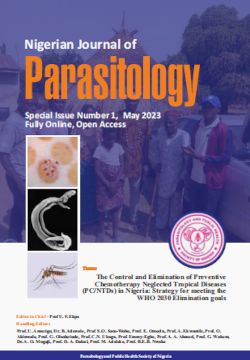Nodules and dermatitis as signs of onchocerciasis in some communities of Aniocha North Local Government Area, Delta State, Nigeria
http://dx.doi.org/10.4314/njpar.v40i1.16
Keywords:
Delta State, Aniocha North, OnchocerciasisAbstract
Onchocerciasis is a major public health concern in sub-Saharan Africa as it affects all age groups and it causes irreversible blindness and severe skin problems in infected individuals. Infection with the disease in Nigeria has been under control with the introduction of Mass Administration of Medicine (MAM) with ivermectin in most affected communities for over a decade. This cross-sectional study which was carried out between November 2008 and March 2009 evaluated the prevalence of the disease in four ivermectin naÅve farming communities namely Idumuogo, Ogodor, Anioma and Ubulubu of Aniocha North Local Government Areas of Delta State, Nigeria. Clinical manifestations of the disease were evaluated on consented 450 participants with the aim of proffering programmatic advice for ivermectin intervention. Data were analysed using SPSS version 16 into simple percentiles, and test for significance. Results showed that 55% (246/450) were males and 45% (204/450) females. An overall onchocerciasis prevalence of 54.22% was recorded across all communities studied. Males were significantly more infected than females (x2 = 176.4, df = 24, p<0.01) and males, 6.91% (140/246) more clinical manifestation then females 50.98% (104/204) . Various degrees of clinical manifestation recorded were: leopard skin 106(24%), onchocercal nodules 32(7.1%), onchodermatitis 51(11.3%), itching 50(11.1%) and impaired vision 18(4.0%) with Idumuogo and Ubulubu, having the highest infections rates of 114(25.3%) and 76(16.9%) respectively. The result of the study showed that the communities surveyed were hypoendermic for onchocerciasis with a nodular rate of 32(7.1%). This information is important to the ongoing elimination efforts of onchocerciasis in Nigeria as the few participants found with nodules could portend as reservoir for transmission where the vectors of the disease thrive. Continuous monitoring of the study-areas is advised so as to measure progress in MAM activities in the State.
References
WHO. 1995. Onchocerciasis and its Control. Report of a WHO Expert Committee on Onchocerciasis Control.World Health Organization Technical Report. 852, pp. 1-104.
Eneanya, G. I. and Nwaorgu, O. C. 2001. Social and psychological aspects of onchocercal skin disease inNkwelle-Ezunaka, Anambra State, Nigeria. The Nigerian Journal of Parasitology, 22 (1 & 2): 11-16.
Dozie, I. N. S., Onwuliri, C. O. E. and Iwuagwu, F. O. 2003. Onochocerciasis in Imo State, Nigeria, clinical and epidemiological studies of anterior segment lesions. Nigerian Journal of Parasitology, 24: 89-94.
Kale, O. O. 1998. Onchocerciasis the burden of the disease. Annals of Tropical Medicine and Parasitology,
: 5109-5115.
Aapredbook Publications. 2009. Onchocerciasis (river blindness, filariasis) (1):476 Org/cgi/content/full/2009/1/3.86.
Adetokunbo, O. L. and Herbert, M. G. 2003. Short Textbook of Public Health Medicine for the Tropics.Power
Book Ltd., London, p. 229.
Ubachukwu, P. O. 2004. Human onchocerciasis: Epidemiological status of Uzo-Uwani Local Government
Area of Enugu State, Nigeria. Nigerian Journal of Parasitology, 25: 93-99.
National Population Commission Asaba. 2006. Population Census Final Results.
Emukah, E. C., Osuoha, E. Miri, E. S., Onyenanya, J., Amazigo, U., Obijuru, C., Osuji, M., Ekeanyanwu, J, Amadiegwu, S., Korve, K. and Richards, F. O. 2004. A longitudinal study of impacts of repeated mass ivermectin treatment on clinical manifestations of onochocerciasis in Imo State. American Journal of Tropical Medicine and Hygiene, 70(5): 556-561.
Akogun, O. B. and Onwuliri, C. O. 1991. Hyperendemic onchocerciasis in persons under twenty years of age in
an endemic area of Northern Nigeria. Annals of Tropical Medicine and Parasitology, 53: 10-29.
Offor, I. I., Vajime C. G., Nock, I. H. and Edeghere, H. U. F. 1998. Studies on similium damnosum complex and onchocerciasis Dalle, Kafachan and Azagba Ogwashuku in Nigeria. The Nigerian Journal of Parasitology, 19:
-32.
Opara, K. N., Udoidung, N. I., Atting I., Oyene, U. E., Adie, H., Aimankhu, P., Ihina V. and Braide E. I. 2006.
Citation Pajiah, M. and Eneanya, C. I. Nodules and dermatitis as signs of onchocerciasis in some communities of Aniocha North Local Government Area, Delta State, Nigeria, pages 97-102. http://dx.doi.org/10.4314/njpar.v40i1.16
Nigerian Journal of Parasitology ISSN 1117 4145, Volume 40[1] March 2019 Rapid epidemiological mapping of onchocerciesis (REMO) in Iri and Ibiono Ibom Local Government Area of Akwa Ibom State. Nigerian Journal of Parasitology, 2: 33-36.
Onwuliri, C. O. E., Nwoke, B. E. B. Lawal, I. A. and Iwuala, M. O. E. 1987. Onchocerciasis in Plateau State of Nigeria. The prevalence among residents around the ASSOB River. Annals of Tropical Medicine and Parasitology, 81: 49-52.
Gemade, E. I. and Dipeolu, O. O. 1983. Onchocerciasis in the Benue State of Nigeria. Prevalence of the disease
among the Tivs living in the Kwande Local Government Area. Annals of TropicalMedicine and Parasitology, 77
(5): 513-516.
Edungbola, L. D., Nwoke, B. E. B., Onwuliri, C. O. E., Akpu, A. U. C. and Tayo-Mafe, M. 1993. Selection of rapid assessment methods for community diagnosis of onchocerciasis in Nigeria: A Recapitulation. Nigerian Journal of Parasitology, 4: 3-6.
Atu, B. O. and Galadima, M. 2003. Onchocerciasis among the Etulo Communities in Buruku and Katsina Ala LGA of Benue State, Nigeria. Journal of Parasitology, 24: 65-70.
Downloads
Published
How to Cite
Issue
Section
License
Copyright (c) 2023 Nigerian Journal of Parasitology

This work is licensed under a Creative Commons Attribution-NonCommercial-NoDerivatives 4.0 International License.





